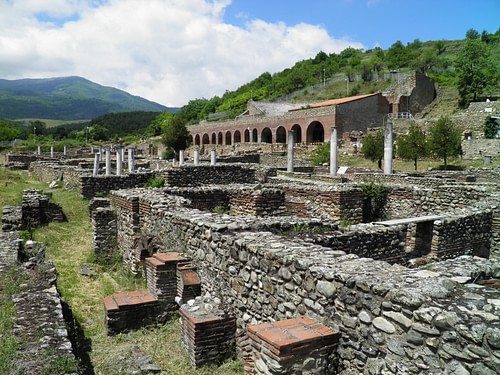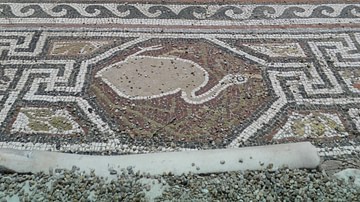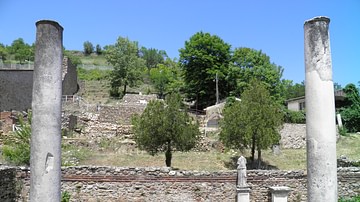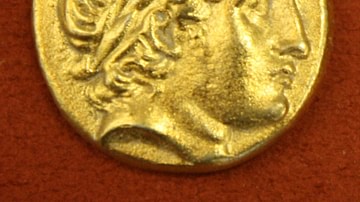
Herakleia Lynkestis (Heraclea Lyncestis; Ἡράκλεια Λυγκηστίς) was a city in the ancient kingdom of Macedon not far from modern Bitola, founded c. 358 BCE by Philip II of Macedon (r. 359-336 BCE) as a governing centre for his new expansions around the older capital, Aigai, east of his current capital, Pella, to secure his western border from further Illyrian invasions.
Although Philip chose the location for strategic reasons, his decision may have been influenced by his mother, Queen Eurydice I of Macedon (c. 410-369 BCE), being originally from the family ruling the Lynkestian tribe. Philip named the new city after the legendary hero Herakles (Hercules), not least because his family of Macedonian rulers, the Argeads, claimed this son of Zeus was their founding father. Herakleia Lynkestis was first built as a defensive citadel. Later developments may not have added much to its expansion but they turned the city into a significant centre of trade and administration.
After the Roman conquest of the Greek world in 146 BCE, Herakleia Lynkestis became a centre for local magistrates, perhaps reflecting the legacy of its most notable figure, Queen Eurydice (whose name means "sound judgment"), and the public reverence for Nemesis, the goddess associated with exacting justice. Thanks to its advantageous location along the so-called Roman highway of the Balkans, Via Egnatia, the city became a popular hub hosting visitors, traders, travelers, and scholars, who were drawn to its vibrant forum, temples (later basilicas), palaces, and theatre.

Lynkestis
Lynkestis, meaning "the place of lynx(es)", was a region east of Lake Prespa in Upper Macedonia, covered with wooded mountains and fertile plains. It was probably named after the earliest tribe attested in written history that inhabited there, the Lynkestai (the Lynkestians). However, it is also possible that the migrant community that finally settled in the region began to call their location by the name of its most common beast, and they were later known by this name.
Archaeology, on the other hand, reveals that the Lynkestis region might have been inhabited long before what ancient writers could tell. The earliest evidence indicating the presence of certain local tribes dates back to the end of the Mycenaean era in the Late Bronze Age, namely c. 1200-1100 BCE. Archaeological finds include pieces of typical Macedonian matt-painted vessels with concentric circles alongside foreign artifacts from distant regions such as Cyprus. This, coupled with Macedonian-style ware found in Boetia, suggests extensive and dynamic trade networks and cultural interactions within the region.
Historical records about the Lynkestians are sparse, and the existing pieces suggest that their community proper, under a verifiable basileus (monarch), began to form no earlier than the mid-7th century BCE. According to the 1st-century BCE Greek geographer Strabo, the local tribes of Upper Macedonia were often ruled by foreigners, who, in the case of the Lynkestians, were descendants of a Corinthian clan, the Bacchiads (7.7.8). They took their name from Bacchis (r. 926-891 BCE), a later successor of Aletes, who was the last Dorian king of Corinth (overthrown in 1074 BCE). The Bacchiads continued to rule Corinth until 784 BCE, when their final king, Telestes, was assassinated by two members of a different Bacchiad faction, Arieus and Perantas (Herodotus 5.92; Pausanias 2.4). Following this regicide, Corinth adopted an oligarchic system of government led by the prytaneis (executive authorities), a polemarchos (commander-in-chief), and a council of elders.

Politically, the rule of a minority group rarely receives positive commentary in ancient texts, and the oligarchy of the Bacchiads is no exception. Herodotus (5.92B) describes the Bacchiads as harsh and autocratic, for example, restricted to marrying within their own clan. However, one of their women, Labda, was born with crooked legs and could not find a husband among the Bacchiads. She was eventually given to an outsider from Petra, although this was likely a different city from the famous one in modern-day Jordan. When Labda gave birth to a son, the Oracle at Delphi prophesied that he would become a great leader. Fearing this, the Bacchiads sought to kill the child. Nevertheless, he survived when his mother hid him in her private chest, from which he got his name, Cypselus, meaning the "chest" or "box". In 655 BCE, Cypselus successfully overthrew the Bacchiad oligarchy and expelled them from Corinth. The exiled Bacchiads moved to Corcyra (modern-day Corfu), and some chose to travel further, eventually becoming rulers of the Lynkestian tribe in Upper Macedonia.
Macedonian Rule
By the 5th century BCE, the Lynkestians were among the prominent nations in Upper Macedonia, capable of checking the expansionist ambitions of their daunting western neighbour, the Illyrians, and their Argead sovereign rulers of Macedonia. In essence, both the Illyrian and Macedonian kingdoms sought to extend their territories by either conquering or forming alliances with the nations of Upper Macedonia.
In 423 BCE, the Battle of Lynkestis occurred between the allied forces of Illyria and Lynkestis and a Spartan-Macedonian coalition. The backdrop of this battle was a period of severe and escalating tensions between Athens and Sparta, the main city-states engaged in the second and final phase of the Peloponnesian War (431-404 BCE). The Lynkestian king, Arrhabaeus, was anxious to confront the Macedonian king, Perdiccas II (r. 454-413 BCE), who had recently secured his eastern borders with Thrace through diplomatic negotiations and secret bribery only to pursue his plans for the conquest of Lynkestis. To strengthen his position, Perdiccas formed an alliance with Sparta and was also promised support from the Illyrians. However, when the time came for Perdiccas II to launch his campaign against Lynkestis, the Illyrians switched sides and sent their forces to assist Arrhabaeus. This shift is largely attributed to Sirras, a Lynkestian-Illyrian commander who had recently married Arrhabaeus' daughter, Irra.
Although the Macedonians were initially successful in their confrontation with the Lynkestian forces, much of their success was due to the support of Spartan troops, commanded by one of the greatest military leaders of the time, Brasidas. However, when the Lynkestians were reinforced by a large group of fierce Illyrian warriors, the poorly trained and undisciplined forces of Perdiccas II chose to retreat, abandoning their Spartan allies on the battlefield. Brasidas, even though unfamiliar with the region and regretful about his failed partnership with the Macedonians, bravely confronted the enemy and, after a prolonged and exhaustive fight and flight, ultimately succeeded in saving his army from the advancing Lynkestian-Illyrian forces.
Following this defeat, Macedonia opted for a more peaceful approach to dealing with Lynkestis. This shift in policy appeared almost unavoidable after 413 BCE, when Archelaus (r. 413-399 BCE), the son and successor of Perdiccas II, attempted another invasion of Lynkestis, only to further expose the incompetence of the Macedonian army. As a result, Archelaus redirected his efforts from expansion to domestic reforms. He focused on improving military infrastructure, moved the capital from ancient Aigai (Aegae) to the newly established city of Pella, a thriving harbour at the time, began minting higher-quality coins, and formed an alliance with Elimeia, another influential state in the region, by marrying one of his daughters to its king. After a period of internal struggles over succession, Archelaus' tradition of effective leadership was continued by Amyntas III (r. in two periods, 393-370 BCE), who secured Macedonian alliances with both Lynkestis and Illyria through his marriage to Eurydice I (r. 393-369 BCE), daughter of the Illyrian commander Sirras and granddaughter of Arrhabaeus of Lynkestis.

The couple had several children, including the future three kings of Macedonia, most notably Philip II, the father of Alexander the Great (r. 336-323 BCE). By marrying a Lynkestian queen, the Argead dynasty effectively completed the annexation of Lynkestis into the Macedonian kingdom. However, the Illyrians refused to acknowledge this arrangement and continued their invasions. Their new king, Bardylis II (r. 393-358 BCE), was a fierce warrior and leader. He defeated both Amyntas III and his son and successor, Perdiccas III (r. 365-360 BCE), who was killed in battle against the Illyrians. Eventually, Bardylis II was defeated and killed in 358 BCE by Philip II, who then secured Macedonia's western borders with Illyria and established Herakleia Lynkestis, initially as a fortified citadel on a hilltop near the border.
At the same time, the presence of a Lynkestian queen created opportunities for her relatives to assert claims to the Macedonian throne whenever circumstances allowed. When Philip II was assassinated in 336 BCE during his daughter's wedding celebrations, his killer, Pausanias of Orestis, was immediately apprehended and executed. Nevertheless, the three sons of Aeropos, a Lynkestian ex-commander of Philip II's army, emerged as primary suspects due to the potential advantages their family could gain from the king's death.
Roman Era & Beyond
Herakleia Lynkestis suffered substantial damage and lost its defensive walls during the Roman conquest of Macedonia in a series of conflicts known as the Macedonian Wars (214-148 BCE). The triumphant Romans divided the kingdom of Macedonia into four provinces and restricted all commercial or marital exchanges between them. Herakleia Lynkestis, now the Roman city of Heraclea Lyncestis, became the capital of the fourth province, Macedonia Quatra. Initially, the city was only treated as an outpost and a supply depot, for example in the campaigns of Julius Caesar (100-44 BCE) during his war against Pompey the Great (106-48 BCE).

Later, under the Roman Empire, the city resumed its growth. Roman emperors, particularly Hadrian (r. 117-138 CE), recognized the strategic importance of a highland city overlooking the intersection of two significant trade routes, the trans-Balkans Via Egnatia and its local main crossing in the Vardar valley heading south to Greece. Developments included a high-street forum, a temple to Zeus, an extensive therma (bathhouse), a 3000-seat theatre, and a magistrate house with a colonnaded portico (porch), transforming Herakleia into a Roman city built with marble and tile. Many inscriptions found at the site indicate an active administrative system managed by both local and foreign officials from South Italy and the East. One notable figure, thanks to his extant inscribed sculpture, is Titus Flavius Orestes, a Roman high priest who successfully chaired the magistrate house for two terms. His statue was found not far from the pedestaled sculpture of the goddess Nemesis in the magistrate house.

Heraclea very probably remained an important centre of episcopal administration in the Early Christian era from the 4th to the 6th century. Several Heraclean bishops are named in the Acts of Church Councils, including Evagrius of Heraclea at the Sardica Council in 343 CE. In 472, the city was sacked by the Ostrogoth king, Theodoric the Great (r. 471-526). In his campaigns to conquer what was left after the fall of the Western Roman Empire, he sacked the city again in 479, ignoring the generous gift sent to him by the bishop of Heraclea. The city was subsequently restored only to last a few more decades before an earthquake prompted its final abandonment in 518. The last coin retrieved from the site dates to c. 585. In the early 7th century, a Slavic tribe known as the Dragovites settled in the area.
Archaeological Site & Museum
Early excavations at the site of Herakleia Lynkestis began in the late 19th century when diplomatic representatives obtained permission from the Ottoman government to excavate and retrieve archaeological artifacts. More systematic excavations conducted between 1936 and 1938 uncovered a small basilica, which was later identified as part of the Great Basilica built over Roman shops in the 5th or 6th century. An episcopal residence, featuring luxurious rooms, was located behind the Great Basilica. This residence contained the most intricate tilework on the site. The floor panel in the central triclinium (dining room) comprises eight panels with meticulously composed arrangements of symbolic plants, animals, and objects.

Excavations have persisted throughout the 20th and 21st centuries and continue to this day. The unearthed artifacts include inscribed pedestals and statues, sculpted figures and objects, coins, vessels, ornaments, and a bone ticket for seat 48 at row 20 in the theatre. Many of these discoveries are now housed at the Archaeological Museum of Heraclea, located at the archaeological site of Herakleia Lynkestis, and at the NI Institute and Museum of Bitola.







